
COACV Pavilion

David Zapatero Gómez, Carlos Lacalle García
 |
Pabellón del COACV COACV Pavilion |
|
| Arquitecto/Architect: David Zapatero Gómez, Carlos Lacalle García |
| ¿Cómo
romper con la dinámica de las ferias donde el visitante no invade el
espacio expositivo sino que pasa “escaneando” con la mirada?
En un ambiente tan agitado y caótico como el de una feria pretendemos colocar un stand que jugase con la información “a medias”. El pabellón consiste en un pequeño “refugio” conscientemente cerrado y elevado del ambiente y entorno exterior. Se cierra al exterior para atraer la atención del visitante no por lo que muestra sino por lo que sugiere. Una estrategia basada en las proyecciones, el movimiento y actividad de las personas en su interior que provoca la curiosidad por descubrir que sucede en su interior. Si desde el exterior se incitaba, a la curiosidad, en el interior se encuentra la respuesta, allí la gente se asoma y ojea las publicaciones, mira los carteles, se encuentra con la gente y contrasta opiniones y experiencias, se sienta a ver la proyección, etc. Un muro-estantería aglutina en un mismo paño el espacio de cartelería, la exposición de publicaciones, el mueble-mesa extraíble, el ordenador personal y el espacio de almacenaje para los pufs. Enfrente, el paño opuesto sirve de pantalla para las video-proyecciones. A los pies de este mueble se surge una pasarela “cat walk” iluminado por donde deambular y dejarse ver, en el resto dejamos un lugar donde sentarse, leer, ver, beber, comer, etc... Utilizamos dos materiales: perfiles huecos metálicos para la estructura y polipropileno prensado translúcido para el recubrimiento de ésta. Este material nos permite esas situaciónes de velo-trasparencia que producen los rebotes y diferentes grados de absorción de luces que buscábamos. La construcción se planteó por módulos de manera que toda la pieza fuera fácilmente montable y desmontable para ser utilizada en diferentes eventos. Señalar que el stand esta cumpliendo con esa “disponibilidad para viajar” que se le requería. |
How
could we break away from the dynamics of such events, where visitors pass
by, ‘scanning’ rather than entering the exhibition spaces?
In the extremely hectic, chaotic atmosphere of an exhibition, our aim was to set up a stand that plays with ‘half-information’. The pavilion is a small, consciously closed ‘refuge’, raised above the exterior atmosphere and surroundings. It is closed off to the exterior in order to attract attention, not through what it shows but through what it suggests. The strategy is based on projections, on the movement and activity of the people inside, making the visitors curious to find out what is happening in the interior. If the exterior incited curiosity, the interior will supply the answer: people drop in and leaf through the publications, look at the posters, meet other people and exchange opinions and experiences, sit down to watch the projections, etc. A shelf wall along one surface combines the poster space, magazine exhibition, pull-out table, PC and storage for the pouffes. The opposite wall serves as a screen for video projections. A lit-up ‘catwalk’ on which to walk and be seen rises from the foot of the shelf wall, the rest is space to sit, read, see, eat, drink, etc. We have used two materials: hollow metal sections for the structure and translucent pressed polypropylene to cover it. This material provides the veiled transparency we were seeking, as the lights bounce off it or are absorbed to different degrees. The construction is modular, designed for easy assembly and taking apart for reuse at other events. The stand therefore fulfils the “readiness to travel” requirement. |
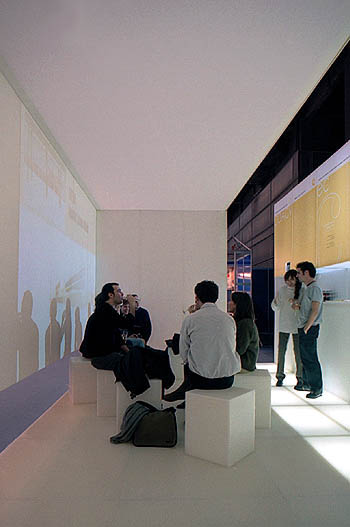 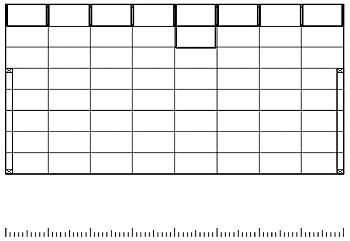 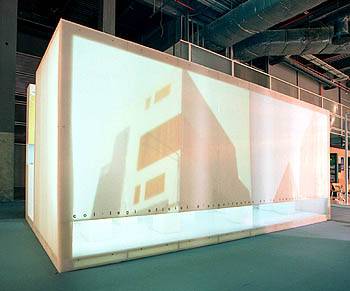 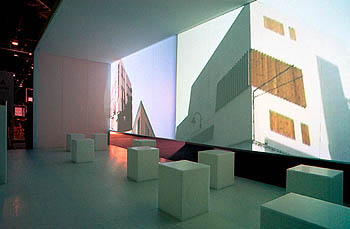 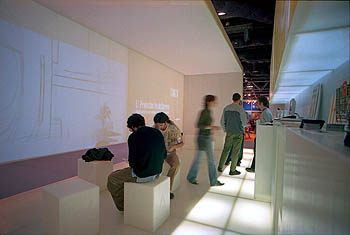 |
Situación
inicial/Situación
inicial: Situaciones
posteriores/Situaciones
posteriores: Promotor/Developer Colaborador/Colaborador: Montaje/Montaje Fotografías/Photographs:
|
 |
|||
 |